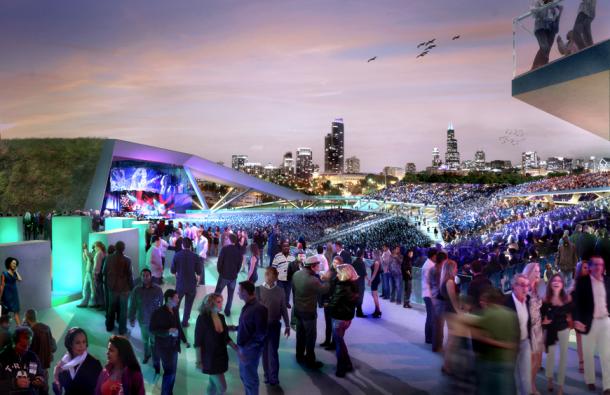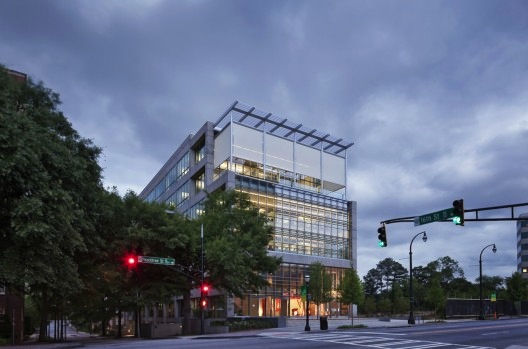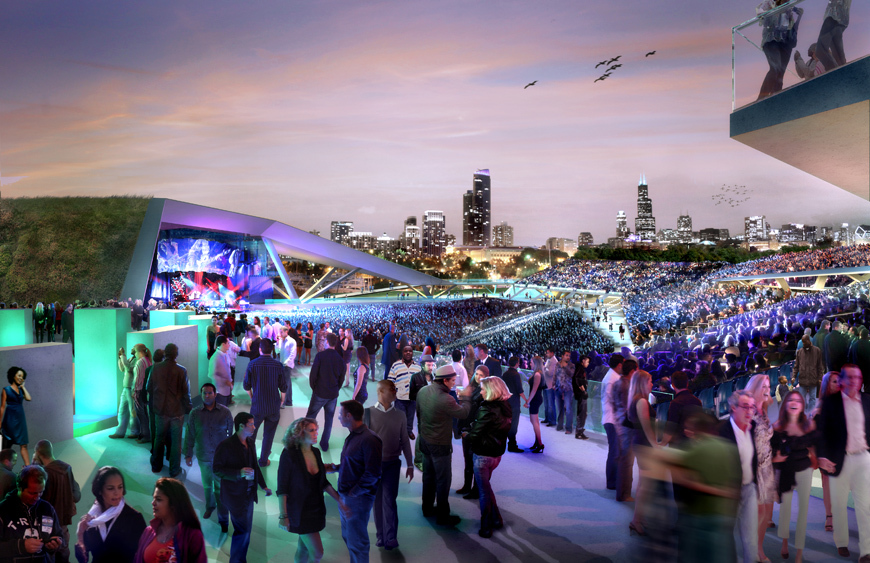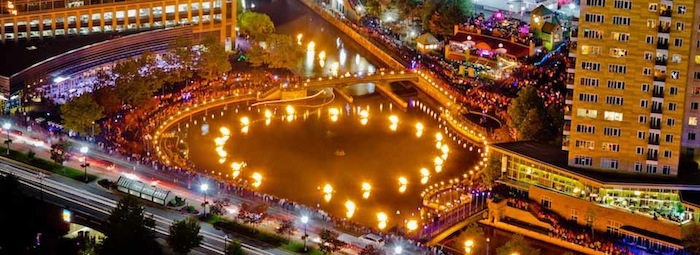An adaptive reuse to create LEED Platinum offices in Georgia, an Ohio park that honors veterans, and a grand national plaza are among the seven projects named winners of the 2013 Great Places Awards. The Environmental Design and Research Association recognize professional and scholarly excellence in environmental design, with special attention paid to the relationship between physical form and human activity or experience.
2013 Place Design Award Recipients
1315 Peachtree Street, Atlanta
Perkins + Will
This LEED Platinum project transformed a 1986 office structure into a "living laboratory" and educational tool for sustainable design. Rigorous research was conducted in pre- and post-occupancy evaluations.
Dublin Grounds of Remembrance
PLANT Architect Inc.
Located in Dublin, Ohio, this one-acre park honors the service of veterans and celebrates the city's heritage. The project examined how architecture can be used to "frame, reveal, and engage the landscape while connecting people to the site and navigating their experience of place." Designers chose not to provide a traditional monument, instead promoting the acts of walking and social gathering.
Place Planning Award Recipients
Northerly Island Park Framework Plan
SmithGroupJJR and Studio Gang Architects
This plan, for an island linked to Chicago's existing lakefront Museum Campus, extends green and sustainable design principles to the waterfont in an ecologically driven plan. The framework establishes zones ranging from urban/active to natural/passive, and includes woodland and waterfront ecology.
Unified Ground: National Mall Competition, Union Square
Gustafson Guthrie Nichol
This plan overlays and enriches the Union Square plaza in the nation's capital with spaces for informal activities. New features and textures respond to the underlying natural landform, daily patterns of movement, and the diverse needs and desires of the users. The plan extends the formal Mall axis to Union Square, including a pool, plaza, and additional pathways.
Place Research Award Recipient
Pop Up City: Temporary Use Strategies for a Sinking City
Cleveland Urban Design Collaborative
Pop Up City is an action-based research program that implements temporary projects as a means of urban reinvention. The research is part of the graduate architecture curriculum at Kent State University, encompassing design-build exercises that culminate in deployment and assessment of temporary projects. (The photo is of Hipp Deck, an outdoor performance venue temporarily created at a parking deck that was once the site of the city's famous Hippodrome Theater.)
Place Book Award Recipient
"Urban Composition," by Mark Childs
This book, which addresses designers but also serves as a teaching tool for urban design, discusses how architects, landscape architects, civil engineers, public artists, city council members, and other participants can caollaborate to create environmentally sound, socially resilient, and "soul enlivening" settlements.
Placemaking Award: Providence
WaterFire Providence
WaterFire Providence, a nonprofit arts organizaton, manages an evolving public art installation of music, floating fires, art, and dance along three rivers in downtown Providence. The project continually changes in response to citizen participation and ongoing expansion of the river park system.
Jurors for the 2013 Great Places Awards:
- Julian Bonder, Principal, Wodiczko + Bonder
- Gayle Epp, Partner, EJP Consulting
- Valerie Fletcher, Executive Director, Institute for Human Centered Design
- Peter M. Hourihan, LEED®AP, Principal & Director of Research, Cannon Design
- Mikyoung Kim, Principal & Design Director, Mikyoung Kim Design.
Related Stories
MFPRO+ New Projects | Oct 30, 2024
BIG’s One High Line finally reaches completion in New York City’s West Chelsea neighborhood
One High Line, a luxury residential project spanning a full city block in New York’s West Chelsea neighborhood, reached completion this summer following years of delays related to investor lawsuits.
Urban Planning | Oct 30, 2024
Bridging the gap: How early architect involvement can revolutionize a city’s capital improvement plans
Capital Improvement Plans (CIPs) typically span three to five years and outline future city projects and their costs. While they set the stage, the design and construction of these projects often extend beyond the CIP window, leading to a disconnect between the initial budget and evolving project scope. This can result in financial shortfalls, forcing cities to cut back on critical project features.
MFPRO+ New Projects | Oct 30, 2024
Luxury waterfront tower in Brooklyn features East River and Manhattan skyline views
Leasing recently began for The Dupont, a 41-story luxury rental property along the Brooklyn, N.Y., waterfront. Located within the 22-acre Greenpoint Landing, where it overlooks the newly constructed Newtown Barge Park, the high-rise features East River and Manhattan skyline views along with 20,000 sf of indoor and outdoor communal space.
Libraries | Oct 30, 2024
Reasons to reinvent the Midcentury academic library
DLR Group's Interior Design Leader Gretchen Holy, Assoc. IIDA, shares the idea that a designer's responsibility to embrace a library’s history, respect its past, and create an environment that will serve student populations for the next 100 years.
Resiliency | Oct 29, 2024
Climate change degrades buildings slowly but steadily
While natural disasters such as hurricanes and wildfires can destroy buildings in minutes, other factors exacerbated by climate change degrade buildings more slowly but still cause costly damage.
Office Buildings | Oct 29, 2024
Editorial call for Office Building project case studies
BD+C editors are looking to feature a roundup of office building projects for 2024, including office-to-residential conversions. Deadline for submission: December 6, 2024.
Healthcare Facilities | Oct 28, 2024
New surgical tower is largest addition to UNC Health campus in Chapel Hill
Construction on UNC Health’s North Carolina Surgical Hospital, the largest addition to the Chapel Hill campus since it was built in 1952, was recently completed. The seven-story, 375,000-sf structure houses 26 operating rooms, four of which are hybrid size to accommodate additional equipment and technology for newly developed procedures.
Multifamily Housing | Oct 28, 2024
A case for mid-rise: How multifamily housing can reshape our cities
Often referred to as “five-over-ones,” the mid-rise apartment type is typically comprised of five stories of apartments on top of a concrete “podium” of ground-floor retail. The main criticism of the “five-over-one” is that they are often too predictable.
Sports and Recreational Facilities | Oct 24, 2024
Stadium renovation plans unveiled for Boston’s National Women’s Soccer League
A city-owned 75-year-old stadium in Boston’s historic Franklin Park will be renovated for a new National Women’s Soccer League team. The park, designed by Fredrick Law Olmsted in the 1880s, is the home of White Stadium, which was built in 1949 and has since fallen into disrepair.
Laboratories | Oct 23, 2024
From sterile to stimulating: The rise of community-centric life sciences campuses
To distinguish their life sciences campuses, developers are partnering with architectural and design firms to reimagine life sciences facilities as vibrant, welcoming destinations. By emphasizing four key elements—wellness, collaboration, biophilic design, and community integration—they are setting their properties apart.
























